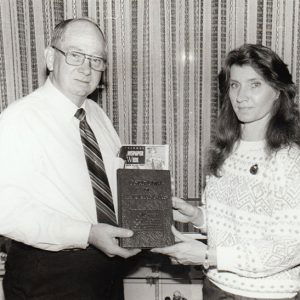calsfoundation@cals.org
Osro Cobb (1904–1996)
Osro Cobb was a lawyer who, as state chairman of the Republican Party, helped establish a real two-party political system in Arkansas. He was U.S. district attorney for the Eastern District of Arkansas during the 1957 desegregation crisis at Central High School in Little Rock (Pulaski County). He was also appointed to the Arkansas Supreme Court by Governor Orval Faubus in 1966, becoming the first Republican to hold a position on the court since 1874.
Osro Cobb was born near Hatton (Polk County) on May 28, 1904, to Philander Cobb, a businessman in the lumber industry, and Ida Sublette Cobb, a writer, poet, playwright, and songwriter; he had two brothers. Cobb’s family relocated frequently due to his father’s business dealings, moving to Womble (later called Norman), and, later, Caddo Gap, both in Montgomery County, where Cobb and his brothers grew up. Cobb frequently followed his father to work as a child and took an interest in the family business.
In the fall of 1920, he entered Henderson-Brown College. While in college, Cobb arrived at a conviction that increased political competition from a strong Republican Party would earn Arkansas more attention from presidential candidates during elections and thus improve the state’s economic and political fortunes. He graduated with a BA and a BS in the spring of 1925.
In 1926, Cobb ran as a Republican and was elected as Montgomery County’s representative to the Arkansas House of Representatives. He served for two terms. During this time, he attended what is now the University of Arkansas at Little Rock William H. Bowen School of Law. Cobb received his LLB degree and was admitted to practice law before the Arkansas Supreme Court on July 8, 1929. Several senior partners at his employer—the Little Rock firm Campbell, Mallory, and Throgmorton—were Republicans. Through these connections, Cobb was appointed assistant U.S. attorney while continuing to practice law privately (at the time, this was not considered a conflict of interest). In 1932, Cobb became chairman of the Arkansas Republican Party. He held that position until 1955.
In 1936, Cobb unsuccessfully ran for governor as a Republican against Democrat Carl Bailey. In the spring of 1938, Cobb met oil heiress Audrey Umsted while golfing, and they married on September 15, 1938. The Cobbs adopted one son. In the late 1930s, Cobb formed his own firm, Cobb, Cazort, and Holt, in Little Rock, but it was dissolved at the beginning of World War II.
In 1942, Cobb joined the U.S. Army Air Corps as a first lieutenant, eventually attaining the rank of lieutenant colonel. He worked as a judge advocate and a law officer for all courts-martial at Berry Field in Nashville, Tennessee, and later at Rosecrans Field in St. Joseph, Missouri. At Wright-Patterson Field in Dayton, Ohio, he worked on aircraft parts contracts for the Army Air Corps. He was discharged in 1946.
In 1946, Cobb returned to Little Rock and opened a firm with lawyer John E. Coates in the Pyramid Building. Cobb practiced law for various timber companies. He helped organize the Arkansas Wood Products Association, later renamed the Arkansas Forestry Association, and established himself in the oil business with the purchase of land leases for 300 acres of land near Smackover (Union County). With the help of former governor Sid McMath, Cobb helped to pass Initiated Act 3 of 1948, which guaranteed that a member of the minority party could work at each polling place.
In 1954, Cobb was appointed U.S. attorney for the Eastern District of Arkansas. During the desegregation crisis at Central High School in September 1957, Cobb gathered intelligence about the situation as it unfolded and communicated this information to the Federal Bureau of Investigation (FBI), the Department of Justice, and the White House. Cobb, along with Attorney General Herbert Brownell Jr., represented the government’s position in court against Governor Faubus, who opposed the desegregation of Little Rock schools on the grounds that it would lead to violence. In his memoirs, Cobb, using evidence from the FBI’s investigation, contended that violent threats from segregationists were overstated by Faubus’s office.
In late 1965, Faubus asked Cobb to fill a vacancy on the Arkansas Supreme Court after Justice Sam Robinson retired. On January 11, 1966, Cobb was sworn in. He served the remainder of Robinson’s term through 1966.
In the late 1960s, Cobb focused on his oil and timber interests. His first wife died in 1976. Later that year, he began dating Martha Jane Rebsamen, a longtime friend of the family, who also was recently widowed. They married on January 26, 1977.
Cobb published two editions of his autobiography, in 1989 and 1990. He died in Little Rock on January 18, 1996.
For additional information:
Cobb, Osro. Osro Cobb of Arkansas: Memoirs of Historical Significance. Little Rock: Rose Publishing Company, 1989.
Osro Cobb Papers. University of Central Arkansas Archives and Special Collections, Conway, Arkansas.
Aaron W. Rogers
Conway, Arkansas
 Cobb Book Presentation
Cobb Book Presentation 



Comments
No comments on this entry yet.